Traditionalist Issues
 |
 |
 |
 |
 |
 |
 |
Dialogue Mass - XI
How Bugnini Grew Up under Pius XII
Fr. Annibale Bugnini, CM, was a priest of the Congregation of the Mission, an institution founded by St. Vincent de Paul (hence the epithet Vincentian) to preach the Gospel to the poor, as its motto, “evangelizare pauperibus” indicates. In 1947, a scandal arose in the residence where Bugnini and his co-worker, Fr. Francesco Bossarelli, CM, lived in Rome at the Church of San Silvestro al Quirinale, which belonged to the Congregation of the Mission.
Inside the murky world of San Silvestro: the ‘Bossarelli Case’
Bugnini and Bossarelli had been close collaborators, running the Congregation’s affairs at San Silvestro and editing its missionary publications, Edizioni Liturgiche e Missionarie.
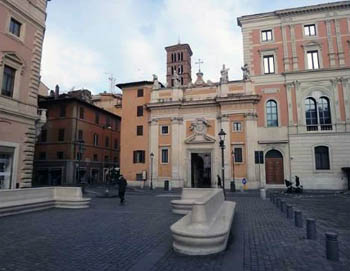 Records from the Vincentian archives show that in 1947 Bugnini, as Secretary (see
here) of the Congregation’s Provincial Council, (1) was in charge of its administrative affairs when millions of dollars of Vatican funds went missing.
Records from the Vincentian archives show that in 1947 Bugnini, as Secretary (see
here) of the Congregation’s Provincial Council, (1) was in charge of its administrative affairs when millions of dollars of Vatican funds went missing.
A special Commission set up by Pius XII found that Fr. Francesco Bossarelli “and his associates” were guilty of embezzling $2,000,000 belonging to the Vatican in “black market financial dealings.” (2) (see here, pp. 49-50 and here, p. 2 - Shades of Sindona and the P2 Masonic Lodge).
The Provincial Superior at San Silvestro was dismissed by the Holy See for covering up the affair. Bugnini must also have had confidential knowledge of these criminal activities, a situation from which he could not have emerged with clean hands.
Hiding behind a shield of secrecy
Unknown to Pius XII, Fr. Bugnini had been making clandestine visits to the Centre de Pastorale Liturgique (CPL), a progressivist conference centre for liturgical reform which organized national weeks for priests.
Inaugurated in Paris in 1943 on the private initiative of two Dominican priests (3) under the presidency of Fr. Lambert Beauduin, it was a magnet for all who considered themselves in the vanguard of the Liturgical Movement. It would play host to some of the most famous names who influenced the direction of Vatican II: Frs. Beauduin, Guardini, Congar, Chenu, Daniélou, Gy, von Balthasar, de Lubac, Boyer, Gelineau etc.
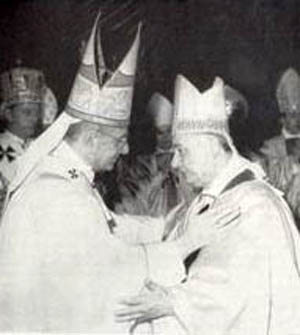 It could, therefore, be considered as the confluence of all the forces of Progressivism, which saved and re-established Modernism condemned by Pope Pius X in Pascendi.
It could, therefore, be considered as the confluence of all the forces of Progressivism, which saved and re-established Modernism condemned by Pope Pius X in Pascendi.
According to its co-founder and director, Fr. Pie Duployé, OP, Bugnini had requested a “discreet” invitation to attend a CPL study week held near Chartres in September 1946:
“I had a visit from an Italian Lazarist, (4) Fr. Bugnini, who had asked me to obtain an invitation for him… During our return journey to Paris, as the train was passing along the Swiss Lake at Versailles, he said to me: 'I admire what you are doing, but the greatest service I can render you is never to say a word in Rome about all that I have just heard.'” (5)
Much more was involved here than the issue of secrecy. The person whose heart beat as one with the interests of the reformers would return to Rome to be placed by an unsuspecting Pope in charge of his Commission for the General Reform of the Liturgy.
The plot thickens
But someone in the Roman Curia did know about the CPL – Msgr. Giovanni Battista Montini, the acting Secretary of State (6) and future Paul VI – who sent a telegram (see here, p. 3) to the CPL dated January 3, 1947. It purported to come from the Pope with an apostolic blessing. If, in Bugnini’s estimation, the Roman authorities were to be kept in the dark about the CPL so as not to compromise its activities, a mystery remains. Was the telegram issued under false pretences, or did Pius XII really know and approve of the CPL?
What is certain is that Fr. Bugnini could not have been appointed as Secretary of the 1948 Commission without Msgr. Montini’s intervention with Pius XII, as it was the Secretary of State who, in the normal course of Vatican affairs, had the biggest say in forwarding names for papal appointments.
Sow Bugnini, reap corruption
As history has shown, appointing Bugnini as Secretary of the Liturgical Commission was the equivalent of placing Dracula in charge of the blood bank. This monstrous figure was allowed to assume complete control of the Commission and to work against a centralized control of the liturgy vested in the Curia.
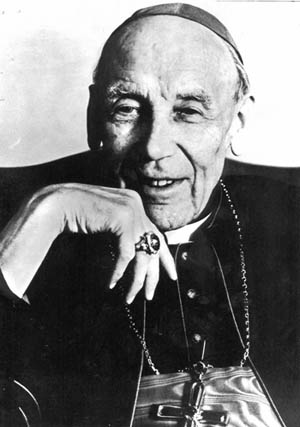 His ultimate foe was the Congregation of Rites, which had been founded by Pope Sixtus V in 1588 to safeguard the uniformity of the Roman Rite. He complained that “for centuries the Church willed that all worship in the Roman Rite should everywhere show perfect uniformity.” (7)
His ultimate foe was the Congregation of Rites, which had been founded by Pope Sixtus V in 1588 to safeguard the uniformity of the Roman Rite. He complained that “for centuries the Church willed that all worship in the Roman Rite should everywhere show perfect uniformity.” (7)
His objective was to smash “the hegemony of the Congregation of Rites.” (8) Soon it would be reduced to a tin pot army incapable of defending the realm of the Church’s worship against his policy of “inculturation.” Then, it would be abolished by Paul VI in 1969.
Fr. Bugnini informs us in his posthumous memoirs that the Commission met in “absolute secrecy.” The result was that not even the Pope could be certain of its deliberations. The only updates he received were relayed through biased intermediaries: Msgr. Montini whose own credibility was bound up with the reforms and Fr. Augustin Bea, a member of the Commission, who had already been permitted by Pius XII to dabble in liturgical matters and break with Tradition. (9)
Bugnini stated: “The Commission enjoyed the full confidence of the Pope, who was kept informed by Msgr. Montini, and even more so, weekly, by Fr. Bea, the confessor of Pius XII. Thanks to this intermediary, we could arrive at remarkable results, even during the periods when the Pope's illness prevented anyone else getting near him.” (10)
The reason for the secrecy was not hard to find: Fr. Bugnini’s agenda included liturgical deviations condemned by Pius XII in Mediator Dei, even though he could not introduce them all immediately. In the light of this collusion, the Novus Ordo of 1969 was simply the end game of a decades-long strategy masterminded by Fr. Bugnini with Msgr. Montini acting as his personal consigliere and “Grand Vizier” to Pius XII.
The hermeneutic of ‘Bugninuity’
One of the most objectionable characteristics of Bugnini was his capacity for deception. He crossed his heart and swore repeatedly that he was carrying out the wishes of Pope Pius X and following the tradition of the Council of Trent in overhauling the liturgy. (11) His self-declared aim was to return the liturgy of the Roman Rite from a “dark age” of unintelligibility to “worship in spirit and truth” in which all could actively participate. (12)
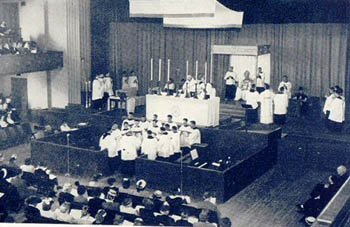
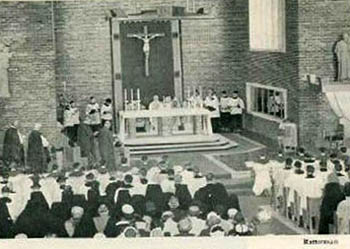 This agenda was set out as early as 1949 in the Ephemerides Liturgicae, a leading Roman review on liturgical studies of which Fr. Bugnini was Editor from 1944 to 1965.
This agenda was set out as early as 1949 in the Ephemerides Liturgicae, a leading Roman review on liturgical studies of which Fr. Bugnini was Editor from 1944 to 1965.
First, he denigrated the traditional liturgy as a dilapidated building (“un vecchio edificio”), which should be condemned because it was in danger of falling to pieces (“sgretolarsi”) and, therefore, beyond repair.
Then, he criticized it for its alleged “deficiencies, incongruities and difficulties,” which rendered it spiritually “sterile” and would prevent it appealing to modern sensibilities. (13)
It is difficult to understand how, in the same year that he published this anti-Catholic diatribe, he was made a Professor of Liturgy in Rome’s Propaganda Fide (Propagation of the Faith) University. (14)
His solution was to return to the simplicity of early Christian liturgies and jettison all subsequent developments, especially traditional devotions. (15)
These ideas expressed in 1949 would form the foundational principles of Vatican II’s Sacrosanctum Concilium. For all practical purposes, the Roman Rite was dead in the water many years before it was officially buried by Paul VI.
Continued

Inside the murky world of San Silvestro: the ‘Bossarelli Case’
Bugnini and Bossarelli had been close collaborators, running the Congregation’s affairs at San Silvestro and editing its missionary publications, Edizioni Liturgiche e Missionarie.

Bugnini and Bossarelli plotted from the Church of San Silvestro al Quirinale in Rome
A special Commission set up by Pius XII found that Fr. Francesco Bossarelli “and his associates” were guilty of embezzling $2,000,000 belonging to the Vatican in “black market financial dealings.” (2) (see here, pp. 49-50 and here, p. 2 - Shades of Sindona and the P2 Masonic Lodge).
The Provincial Superior at San Silvestro was dismissed by the Holy See for covering up the affair. Bugnini must also have had confidential knowledge of these criminal activities, a situation from which he could not have emerged with clean hands.
Hiding behind a shield of secrecy
Unknown to Pius XII, Fr. Bugnini had been making clandestine visits to the Centre de Pastorale Liturgique (CPL), a progressivist conference centre for liturgical reform which organized national weeks for priests.
Inaugurated in Paris in 1943 on the private initiative of two Dominican priests (3) under the presidency of Fr. Lambert Beauduin, it was a magnet for all who considered themselves in the vanguard of the Liturgical Movement. It would play host to some of the most famous names who influenced the direction of Vatican II: Frs. Beauduin, Guardini, Congar, Chenu, Daniélou, Gy, von Balthasar, de Lubac, Boyer, Gelineau etc.

Archbishop Bugnini greeted by Pope Montini, who since he was a Monsignor cleared the way for Fr. Bugnini's work of destruction
According to its co-founder and director, Fr. Pie Duployé, OP, Bugnini had requested a “discreet” invitation to attend a CPL study week held near Chartres in September 1946:
“I had a visit from an Italian Lazarist, (4) Fr. Bugnini, who had asked me to obtain an invitation for him… During our return journey to Paris, as the train was passing along the Swiss Lake at Versailles, he said to me: 'I admire what you are doing, but the greatest service I can render you is never to say a word in Rome about all that I have just heard.'” (5)
Much more was involved here than the issue of secrecy. The person whose heart beat as one with the interests of the reformers would return to Rome to be placed by an unsuspecting Pope in charge of his Commission for the General Reform of the Liturgy.
The plot thickens
But someone in the Roman Curia did know about the CPL – Msgr. Giovanni Battista Montini, the acting Secretary of State (6) and future Paul VI – who sent a telegram (see here, p. 3) to the CPL dated January 3, 1947. It purported to come from the Pope with an apostolic blessing. If, in Bugnini’s estimation, the Roman authorities were to be kept in the dark about the CPL so as not to compromise its activities, a mystery remains. Was the telegram issued under false pretences, or did Pius XII really know and approve of the CPL?
What is certain is that Fr. Bugnini could not have been appointed as Secretary of the 1948 Commission without Msgr. Montini’s intervention with Pius XII, as it was the Secretary of State who, in the normal course of Vatican affairs, had the biggest say in forwarding names for papal appointments.
Sow Bugnini, reap corruption
As history has shown, appointing Bugnini as Secretary of the Liturgical Commission was the equivalent of placing Dracula in charge of the blood bank. This monstrous figure was allowed to assume complete control of the Commission and to work against a centralized control of the liturgy vested in the Curia.

Card. Bea, confessor of Pius XII, won the Pope to the cause of the reforms
His objective was to smash “the hegemony of the Congregation of Rites.” (8) Soon it would be reduced to a tin pot army incapable of defending the realm of the Church’s worship against his policy of “inculturation.” Then, it would be abolished by Paul VI in 1969.
Fr. Bugnini informs us in his posthumous memoirs that the Commission met in “absolute secrecy.” The result was that not even the Pope could be certain of its deliberations. The only updates he received were relayed through biased intermediaries: Msgr. Montini whose own credibility was bound up with the reforms and Fr. Augustin Bea, a member of the Commission, who had already been permitted by Pius XII to dabble in liturgical matters and break with Tradition. (9)
Bugnini stated: “The Commission enjoyed the full confidence of the Pope, who was kept informed by Msgr. Montini, and even more so, weekly, by Fr. Bea, the confessor of Pius XII. Thanks to this intermediary, we could arrive at remarkable results, even during the periods when the Pope's illness prevented anyone else getting near him.” (10)
The reason for the secrecy was not hard to find: Fr. Bugnini’s agenda included liturgical deviations condemned by Pius XII in Mediator Dei, even though he could not introduce them all immediately. In the light of this collusion, the Novus Ordo of 1969 was simply the end game of a decades-long strategy masterminded by Fr. Bugnini with Msgr. Montini acting as his personal consigliere and “Grand Vizier” to Pius XII.
The hermeneutic of ‘Bugninuity’
One of the most objectionable characteristics of Bugnini was his capacity for deception. He crossed his heart and swore repeatedly that he was carrying out the wishes of Pope Pius X and following the tradition of the Council of Trent in overhauling the liturgy. (11) His self-declared aim was to return the liturgy of the Roman Rite from a “dark age” of unintelligibility to “worship in spirit and truth” in which all could actively participate. (12)

A reform already in practice in the '50s in Portland, above, and Kansas City, below

First, he denigrated the traditional liturgy as a dilapidated building (“un vecchio edificio”), which should be condemned because it was in danger of falling to pieces (“sgretolarsi”) and, therefore, beyond repair.
Then, he criticized it for its alleged “deficiencies, incongruities and difficulties,” which rendered it spiritually “sterile” and would prevent it appealing to modern sensibilities. (13)
It is difficult to understand how, in the same year that he published this anti-Catholic diatribe, he was made a Professor of Liturgy in Rome’s Propaganda Fide (Propagation of the Faith) University. (14)
His solution was to return to the simplicity of early Christian liturgies and jettison all subsequent developments, especially traditional devotions. (15)
These ideas expressed in 1949 would form the foundational principles of Vatican II’s Sacrosanctum Concilium. For all practical purposes, the Roman Rite was dead in the water many years before it was officially buried by Paul VI.
Continued
- Catalogue des Maisons et du Personnel de la Congrégation de la Mission 1947, “V1947” (1947), Personnel Catalogues, Paper 86, p. 73. Francesco Bossarelli, CM is also mentioned on page 73 as a “consultor.”
- The special Commission insisted that the burden of repayment to the Holy See should fall on the entire Vincentian community around the world. To satisfy the Pontifical Commission, the Congregation’s Motherhouse in Paris asked the American Provinces to arrange for loans of the essential money because no other Provinces could raise the required funds in the aftermath of the war. It was not until 1966 that the debt was fully paid.
- Frs. P. Duployé and A-M. Roguet. Its mission was to promote the Liturgical Movement by organizing conferences, encouraging research and publishing liturgical studies in its magazine, La Maison-Dieu, which was produced by the Dominican publishing house, Editions du Cerf.
- In addition to the term Vincentians, priests of the Congregation of the Mission were sometimes called Lazarists after the Maison St. Lazare in Paris where St. Vincent de Paul had lived and worked.
- P. Duployé, Les origines du CPL, Mulhouse, Salvator, 1968, p. 308. Forty religious superiors and seminary rectors were assembled there under the chairmanship of Mgr. Harscouёt, Bishop of Chartres, a supporter of Beauduin since 1909.
Among the speakers were Fr. Daniel Perrot, Rector of the Seminary of the Mission de France for worker-priests, Fr. Pie Régamey, OP, editor of the review L'Art Sacré who advocated a minimalist style of church decoration, Fr. Yves Congar, OP, a progressivist theologian and pioneer of ecumenism, Fr. A-G Martimort, a convenor of CPL events and future drafter of Sacrosanctum Concilium, the above-mentioned Fr. Duployé, OP, and the ubiquitous Fr. Beauduin. - After the death of the last Secretary of State in 1944, Pius XII did not appoint a successor, but gave Mgr. Montini the role of “Substitute” and later “Pro-Secretary of State.” This does not mean that Montini was a minor functionary; he was responsible for both the Church’s external relations with other countries and the internal relations among the various other offices of the Church. In his capacity, he had discretion as to who should see the Pope, what information reached him and which persons should be considered for appointment to Vatican posts.
- A. Bugnini, The Reform of the Liturgy 1948-75, Collegeville, Liturgical Press, 1990, p. 42.
- Apud Denis Crouan, The History and the Future of the Roman Liturgy, Ignatius Press, 2005, p. 136.
- In 1945, Pope Pius XII approved for use in the Divine Office a new Latin version of the Psalms, the work of a committee of experts at the Pontifical Biblical Institute in Rome under the direction of Fr. Bea, SJ.
The committee made a complete break with tradition by discarding the biblical and liturgical Latin that had been used in the Church since early Christian times. In its place they used a form of Classical Latin borrowed from the humanistic tradition of the ancient Romans, which had a different connotation. Even its rhythm was unfit for Catholic purposes as it could not be easily sung to Gregorian Chant. This innovation introduced by Pius XII could not be regarded as an example of the “hermeneutic of continuity.” Rather we should call it the “Bea-tification” of the Psalter. - A. Bugnini, The Reform of the Liturgy 1948-75, p. 9
- Interestingly, Pope Paul VI perpetuated the same myth when he stated in his Apostolic Constitution Missale Romanum of April 3, 1969 that the Novus Ordo and the liturgical reform resulting from Vatican II were a continuation of the developments of previous centuries, including the Council of Trent.
- A. Bugnini, The Reform of the Liturgy 1948-75, p.283
- A. Bugnini, “Per una Riforma Liturgica Generale,” in Ephemerides Liturgicae, March 1949. The “difficulties” he envisaged were references to “negative” aspects of reality such as punishment for sin, divine anger, damnation, eternal punishment, etc. He stated that a general reform would save the Church’s liturgy from the “sterilità” (sterility) and the “archeologismo” (outdatedness) of Tradition. See here
- Also in the reign of Pius XII, he was appointed Professor in the Pontifical Institute of Sacred Music in 1955, Consultor to the Sacred Congregation of Rites in 1956, and Professor of Sacred Liturgy in the Lateran University in 1957.
- Bugnini stated: “La riforma dev'essere concepita come un ritorno alla tradizione primitiva della celebrazione del mistero cristiano piuttosto che come un compromesso tra questa celebrazione in sottordine e le superfetazioni de-vozionali che l'hanno disarticolata nel corso dei secoli.” [The reform must be conceived as a return to the primitive tradition of the Christian mystery, rather than a compromise between a second class celebration and devotional additions that have disjointed it over the centuries.]

Posted August 25, 2014
______________________
______________________
 Volume I |
 Volume II |
 Volume III |
 Volume IV |
 Volume V |
 Volume VI |
 Volume VII |
 Volume VIII |
 Volume IX |
 Volume X |
 Volume XI |
 Special Edition |


